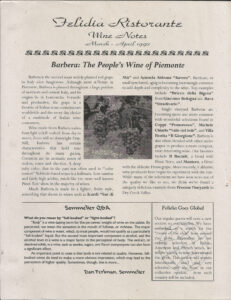 Felidia Ristorante
Felidia Ristorante
Wine Notes
March – April 1997
Barbera: The People’s Wine of Piemonte
Barbera is the second most widely planted red grape in Italy after Sangiovese. Although most at home in Piemonte, Barbera is planted throughout a large portion of northern and central Italy, and its origins lie in Lombardia. Versatile and productive, the grape is a favorite of Italian wine connoisseurs worldwide and the every day choice of a multitude of Italian consumers.
Wine made from Barbera varies from light to full bodied, from dry to sweet, from still to downright fizzy. Still, Barbera has certain characteristics that hold true throughout its many guises. Common are its aromatic notes of violets, roses and cherries. A deep ruby color, that in the past was often used to “color correct” Nebbiolo based wines is a hallmark. Low tannins and fairly high acidity, much like the more well known Pinot Noir show in the majority of wines.
Much Barbera is made in a lighter, fruity style, something that shows in wines such as Icardi “Sur di Mù” and Azienda Abbona “Ravera”. Barrique, or small new barrel, aging is becoming increasingly common to add depth and complexity to the wine. Top examples include “Bricco della Bigota” from Giacomo Bologna and Bava “Stradivario”.
Single vineyard Barberas are becoming more and more common with wonderful selections found in Coppi “Pomorosso”, Michele Chiarlo “Valle del Sole”, and Villa Fiorita “Il Giorgione”. Barbera is also often blended with other native grapes to produce a more complex, more interesting wine. Our favorites include Il Bacialé, a blend with Pinot Nero, and Maneiro, a blend with the delicate Freisa grape. More recently, California wine producers have begun to experiment with the vine. While many of the selections we have seen were not of the quality we like to see, we think we’ve found a uniquely delicious example from Preston Vineyards in Dry Creek Valley.
Sommelier Q&A
What do you mean by “full-bodied” or “light-bodied”?
“Body” is a wine-tasting term for the perceived weight of wine on the palate. By perceived, we mean the sensation in the mouth of fullness, or richness. The major component of wine is water, which, to most people, would not qualify as a particularly “full-bodied” liquid. But the second most important component is alcohol, and the alcohol level in a wine is a major factor in the perception of body. The extract, or dissolved solids, in a wine, such as tannins, sugars, and flavor components can also have a significant effect.
An important point to note is that body is not related to quality. However, full-bodied wines do tend to make a more obvious impression, which may lead to the perception of higher quality. Sometimes, though, less is more….
Felidia Goes Global
Our regular guests will note a new section to our winelist. We have embarked on a search for the “cream of the crop” from around the globe. Expanding on our existing selection of Italian, American and French wines, we will be adding in wine from around the glove. This section with remain intentionally small and very selective, only the best, in our collective opinion, from each country will be included.